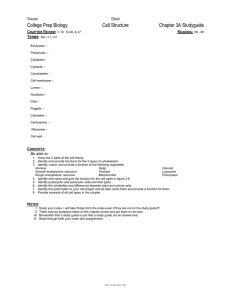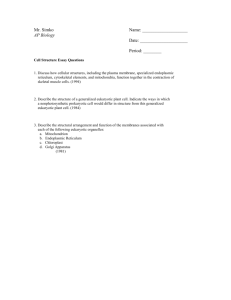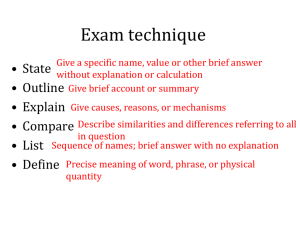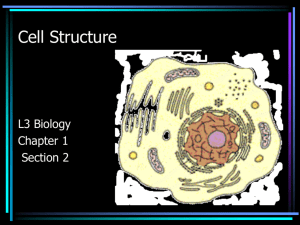Module A.1 Notes
advertisement
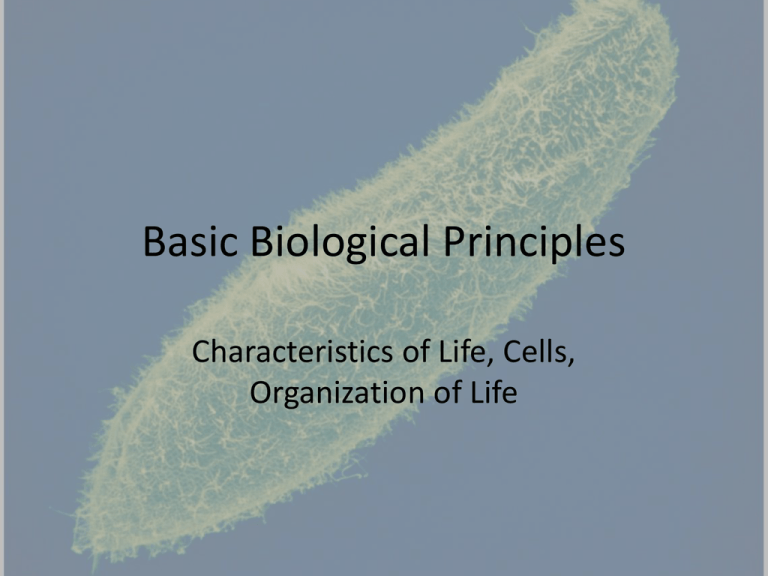
Basic Biological Principles Characteristics of Life, Cells, Organization of Life 7 Characteristics of Life • Living things MUST exhibit these 7 characteristics to be considered living: 1. 2. 3. 4. 5. 6. 7. Order Metabolism Response to a Stimulus Reproduction Homeostasis Growth and Development Evolutionary Adaptation 7 Characteristics of Life • Order – Organized arrangement of parts in a living thing or group of living things • Smallest to largest – – – – – – – Atom Molecules Cell Tissue Organ Organ system Organism • Single-celled organisms stop at the cell level and most multi-celled organisms exhibit all levels (1) Order 7 Characteristics of Life • Metabolism – All of the chemical reactions that take place in an organism – Chemical reactions either break down molecules or build up molecules in the body – Organisms must be able to perform chemical reactions (4) Energy processing 7 Characteristics of Life • Response to a Stimulus – Must be able to react to the environment – Running away from a prey or a plant growing towards light • Reproduction – Produce more of your own kind – Asexual-only ONE parent and make a genetically identical clone to the parent – Sexual-usually more than one parent and make genetically different offspring from the parents (5) Response to the environment (6) Reproduction 7 Characteristics of Life • Homeostasis – Maintain stable internal conditions • Temperature, water, salts, gases and even cell number – If our temperature increases, humans sweat – If water levels drop too low, we get thirsty and our kidneys save water • Growth and development – Increase in size and mature/change from embryo to adult (2) Regulation (3) Growth and development 7 Characteristics of Life • Evolutionary Adaptation – Ability of an entire species to change genetically over generations to survive in a changing environment – Species that do not adapt will become extinct (7) Evolutionary adaptation Cells • Cells – Basic unit of structure and function in a living thing (first level where life appears) – Two types of cells: • Prokaryotic cells-cells that do NOT have a nucleus or membrane-bound organelles • Eukaryotic cells-cells that HAVE a nucleus and membrane-bound organelles Cells • Cell Size – Cells are small to be efficient • Being small allows them to maximize their ability to exchange nutrients and waste with the environment • Cells can become larger by: – Increasing surface area (flat shape and folds in membranes) – Dividing up labor • Prokaryotic cells remain small to maintain efficiency • Eukaryotic cells can be larger because labor is divided into compartments Cells • Similarities between prokaryotic and eukaryotic cells (every cell has these structures): – Cell membranes – Genetic material (DNA) – Ribosomes – Cytoplasm Differences between Prokaryotic and Eukaryotic Cells Prokaryotic Cells Eukaryotic Cells • No nucleus • No membrane-bound organelles • Smaller in size • Circular chromosomes • Nucleus • Membrane-bound organelles • Larger in size • Linear chromosomes Prokaryotic cell DNA (no nucleus) Membrane Nucleus (contains DNA) Organelles Eukaryotic cell Prokaryotic Cell Structure External Structures • Pili • Flagellum • Capsule • Cell wall • Cell membrane Internal Structures • Ribosome • Cytoplasm • Nucleiod • Plasmid • Chromosome Pili Nucleoid Ribosomes Plasma membrane Bacterial chromosome Cell wall Capsule Flagella Eukaryotic Cell Structure (found in both plant and animal cells) • Flagellum • Cilia • Cell (plasma) membrane • Cytoskeleton • Nucleus • Nucleolus • • • • • • • Endoplasmic reticulum Golgi apparatus Lysosome Mitochondrion Centrosome Food vacuole Vesicle NUCLEUS: Nuclear envelope Smooth endoplasmic reticulum Chromosomes Nucleolus Rough endoplasmic reticulum Lysosome Centriole Peroxisome CYTOSKELETON: Microtubule Intermediate filament Microfilament Ribosomes Golgi apparatus Plasma membrane Mitochondrion Eukaryotic Cell Structure • Plant cells only – Cell wall – Central vacuole – Chloroplast NUCLEUS: Nuclear envelope Chromosome Rough endoplasmic reticulum Ribosomes Nucleolus Smooth endoplasmic reticulum Golgi apparatus CYTOSKELETON: Central vacuole Microtubule Chloroplast Cell wall Intermediate filament Plasmodesmata Microfilament Mitochondrion Peroxisome Plasma membrane Cell wall of adjacent cell

